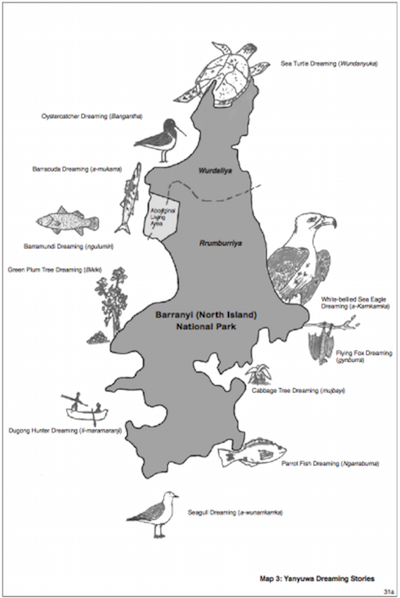

Local descent groups are associated with a tract of land, and people in
such groups have rights in the land and in ceremonies and symbols. The
people in such LDG’s inherit these rights from previous generations.
Social categories (skins) on the other hand do not have such an
association with a tract of land: members of a skin category are
distributed through various local descent groups.
• Clans
• Lineages
It is common for people to have a connection to clan country through
other lines in addition to through the father. Most common is the
connection through the mother’s brother (‘uncle’) and the mother’s
father, sometimes the mother’s mother. In some areas people may be
affiliated to a clan through other connections such as ‘conception
dreaming’, birth place and other life events of the individual or their
parents, but in other regions the importance of such ties is minimized
or dismissed.
A Clan is a group of people, or a number of lineages, whose members
claim to be descendants of a distant ancestor. However in Australia it
is not always, or commonly, the case that totems or dreamings (mythical
figures often with the names of animals) are the ancestors of the
current and former clan members. They generally created sites in the
land, the names of the sites referring to events told in songs
(‘songlines’) used in ceremonies.
Lineage: A group of people who can trace their descent back to a single
known and, in most cases, named human ancestor. Lineages can be
branches of clans, but the exact genealogical connection between the
lineages in a clan may not be known.
• Clans and subsections
• Phratries
• Semi-moieties
Specific clan groups are made up of members of one moiety, two
specific sections or two specific subsections. We begin with how a
Warlpiri person, Steve Jampijinpa Patrick, explains this, and use the
colour scheme that was designed for the Milpirri ceremony at Lajamanu.
We had four [Jukurrpa-Dreaming] stories, each told four different ways.
We then assigned colours for each of the clan groups so that the
individual groups could be easily identified from the audience.
Blue was assigned to the Jangala/Jampijinpa clan, because many of the
Jukurrpa stories in that clan are ngapa (water) stories.
We assigned Green to the Japanangka/Japangardi clan because many of
their Jukurrpa stories are about vegetation.
The Jakamarra/Jupurrurla clan was assigned red because many of their
stories are about animals that are eaten as meat.
Because the Japaljarri/Jungarrayi clan has many bird stories, we
assigned them the colour yellow.
It is amazing, but despite never having been part of the Warlpiri
culture, these colours have been integrated to such a degree that it is
as if it they always were a part of Warlpiri culture.
So, here are the four types of clans with their component subsections
(‘skins’), in Table 4:
Table 4
| Jampijinpa | Japangardi | Jakamarra | Japaljarri |
| Father/son of | Father/son of | Father/son of | Father/son of |
| Jangala | Japanangka | Jupurrurla | Jungarrayi |

There are several clans of each type, an important one of the blue
jangala-jampijina type being the ngapa (rain) dreaming in the Tanami
Desert, to which Steven Patrick Jampijina belongs. Another member was
the artist Peggy Nangala Jurra, who painted this picture of the
dreaming country. Jangala and Nampijinpa are different generations in
the same clan. Here is a description of the painting from National
Gallery of Victoria.
Parardi (Rainbow) Dreaming is associated with the ngapa (water)
Dreaming that also belongs to Nangala and Nampitjinpa women. The
country of the Dreaming is Puyurru where a big rain left to travel
north in the Jukurrpa (Dreaming). As the rain travelled, the Dreaming
created people out of the milpirri (small rain clouds).
The path of the Dreaming follows a karru (creek) with a fresh-water
spring, called Lungkardajarra, shown by the central wavy lines. The
central circles represent milpirriwiri (big clouds); the outer circles,
milpirri (small rain clouds) and the bars indicate mangkurdu (cloud
fronts). The Rainbow Dreaming is indicated by tri-coloured arcs, which
are painted in primary colours to emphasise its radiant power
The clans here are patrilineal. That is, they follow the father line.
So a Nampijinpa could be a father’s sister (pimirdi) to a Jangala who
is her brother’s sister (ngalapi).
If we add the Milpirri colours this kind of subsections diagram shown
in Table 3, it looks like this in Table 5:
Table 5: Warlpiri subsections with Milpirri clan colours
| A1 | Japanangka | B1 | Jupurrurla | |
| A2 | Jungarrayi | B2 | Jangala | |
| C1 | Jakamarra | D1 | Japaljarri | |
| C2 | Jampijinpa | D2 | Japangardi |
North of the Warlpiri are the Gurindji and Mudburra who have skin names
similar to the Warlpiri.
Table 6. Gurindji subsections
| Code | Terms | Code | Terms | |
|---|---|---|---|---|
| A1m A1f | Janama Nanaku | Marry | B1m B1f | Jurlama Nawurla |
| A2m A2f | Jungurra Namija | Marry | B2m B2f | Jangala Nangala |
| C1m C1f | Japarta Nimarra | Marry | D1m D1f | Japalyi Nalyirri |
| C2m C2f | Jampijina Nampijina | Marry | D2m D2f | Jangari Nangari |
| Janama | Jurlama | |||
| Nanaku | Nawurla | |||
| Jungurra | Jangala | |||
| Namija | Nangala | |||
| Japarta | Japalyi | |||
| Nimarra | Nalyirri | |||
| Jampijina | Jangari | |||
| Nampijina | Nangari | |||
Another term which is related to local descent is phratry. This is a
grouping of clans which are seen as related in some way at a higher
level, but does not constitute a moiety: usually there are around four
of these

Semi-moieties are each, as the name implies, half of a moiety, but not
in the same way as sections are. The patri-semi-moieties that are found
in South-east Arnhem Land and further east on the Gulf of Carpentaria
coast are made up of four units, each of which is a patrilineal phratry
(group of clans). As such they each are associated as owners of an area
of country. In the map below it can be seen that each of two of
the Yanyuwa semimoieties, Wurdaliya and Rumburriya own a different part
of an island, which contains sites of the dreamings with which the
clans in each semi-moiety are associated.
However there is an additional feature which distinguishes
semi-moieties from plain phratries. There are marriage rules between
the semi-moieties – one semi-moiety may only marry one particular other
semi-moiety (or sometimes there is a second marriage option). In this
way they are like social categories (sections and subsections).
In most clear cases of semi-moieties, subsections are also found in the
area and there is a straightforward mapping between the two: a
semi-moiety aligns with two subsections which are father-son pair as in
the case of the Warlpiri grouping of subsections.
Source: Barrranyi (North Island) Draft Plan of Management NTPWS 2004:41
Previous page: Social categories
Next page: Non-local descent groups